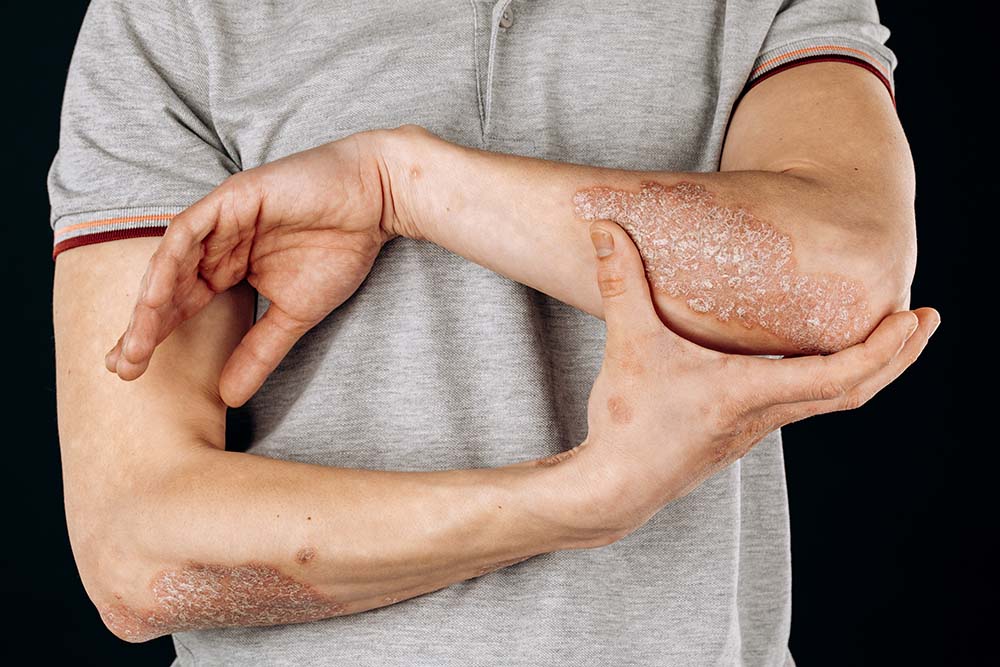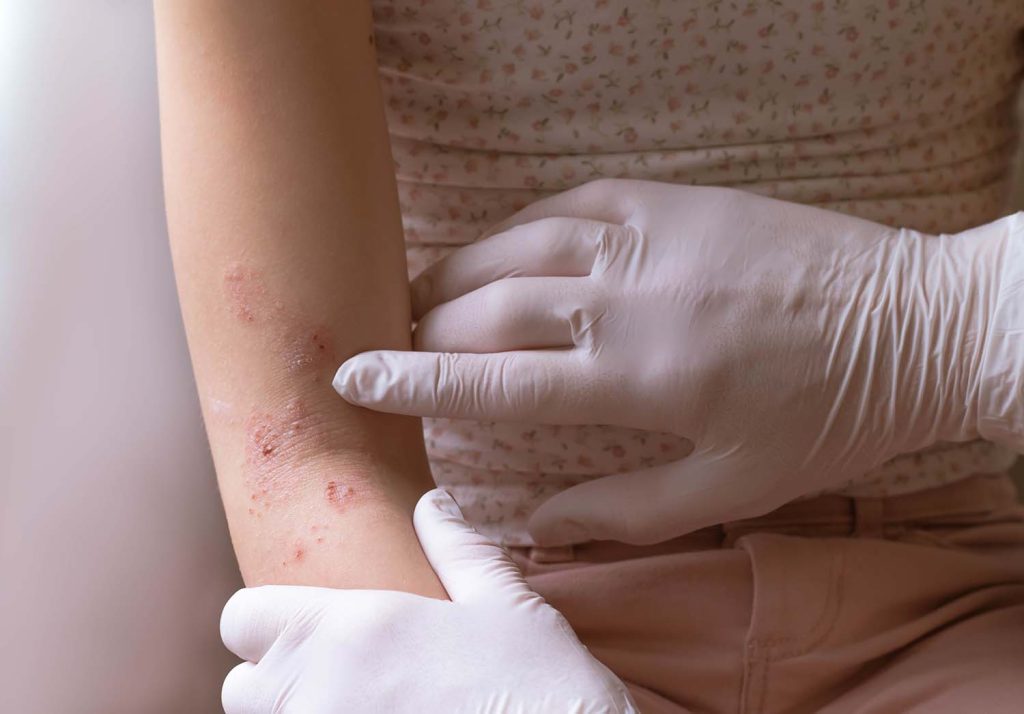When people think of dermatologists, they usually imagine luxury skincare and cosmetic procedures, but that’s only a small part of the job. In reality, dermatology involves managing chronic, painful, and emotionally taxing conditions that deeply affect patients’ quality of life. From autoimmune diseases to rare infections, in this article, Dr Ayesha Moolla offers a look at the demanding and vital role dermatologists play in diagnosing and treating complex skin conditions.

More than just skincare
When people hear the word dermatologist, they usually associate the profession with skincare and aesthetic treatments. And yes, sure, that’s part of our job, but it only comprises a fraction of what we do.
The truth is that much of what we do every single day involves diagnosing and treating skin conditions that are far from glamorous, often being chronic, debilitating, and emotionally distressing.
Psoriasis: More than a rash
Dermatological conditions are far more complex than they may appear. Take psoriasis, for example, it’s not just a rash. It’s an autoimmune disease associated with joint disease, metabolic syndrome, and even increased cardiovascular risks.
I’ve treated young patients with painful, itchy, thick plaques covering large parts of their bodies. Never mind the discomfort, it’s the emotional toll and stigma, and the anxiety of shedding a trail of skin scales anywhere they sit.
The isolation of hidradenitis suppurativa
Hidradenitis suppurativa (HS), a chronic, inflammatory skin condition that causes painful, boil-like lumps to form under the skin, typically in areas where skin rubs together, is another devastating condition and can be rather isolating.
I’ve had patients walk through my door and quietly share their worst fears, like an abscess bursting while they’re at work, or pus draining down their sides during a meeting. Not only do the nodules and abscesses in HS patients occur in the most sensitive areas like the groin and armpits, but they are also physically painful and emotionally exhausting.
The unpredictability, clothing stains, and sheer pain make them suffer in silence before they reach out to a dermatologist who knows exactly what’s going on and what the correct treatment approach is.
Eczema and the toll on families
Atopic dermatitis, or eczema, is another skin condition causing a great deal of anguish in many instances. Some days, I see children with itchy, raw, weeping skin that oozes and bleeds. Parents walk into my room bleary-eyed and exhausted, having been up all night trying to pacify their child’s relentless itching and crying.
The sleep deprivation affects the whole household, and with the kids too tired to concentrate at school, their school performance suffers. As for the parents, they are stretched thin, emotionally and physically, and occasionally have broken down in tears.
Atopic eczema isn’t just a rash; it’s chronic inflammation of the skin that needs more than just moisturisers. Topical and systemic treatments and proper counselling are absolutely necessary.

Acne: More than teenage trouble
Acne may seem like a harmless part of growing up, but for many teenagers, it crushes their self-esteem and social confidence. I’ve had countless parents tell me their child no longer wants to go out, spends hours holed up in their room, glued to a screen, avoiding social interaction.
As dermatologists, we can effectively treat acne with proper medical management and, as their skin clears, we often notice how they begin to re-engage and smile more. Treating acne is not just about trending skincare but tailoring care to each patient’s skin and circumstances.
The emotional impact of pigment and texture disorders
Other conditions, such as vitiligo or acne keloidalis nuchae (a chronic inflammatory skin condition that primarily affects the back of the neck and scalp), can deeply affect patients’ self-esteem, especially in those with deeper skin tones, where visibility and pigmentation have such an impact on them.
When skin tells a bigger story
Then there are other skin conditions that don’t fulfil typical textbook descriptions and require clinical skills.
As dermatologists, we have trained for many years to spot sinister lesions such as early melanomas or other skin cancers. We can tell if a ring-shaped rash is a fungal infection or cutaneous lupus (an autoimmune disease where the immune system mistakenly attacks skin cells, causing inflammation and characteristic skin rashes). Some of my most challenging and rewarding cases have included autoimmune blistering diseases, genodermatoses, and infectious diseases such as cutaneous TB, leprosy, and opportunistic skin infections in the setting of HIV.
In our profession, we also frequently spot manifestations of systemic illness. I’ve had patients present with shingles (herpes zoster) or Kaposi sarcoma, only to later be diagnosed with HIV.
Others have come in with unusual skin lesions, such as eruptive xanthomas, that turn out to be linked to dangerously high cholesterol levels or diabetes.
We know when to refer urgently and appropriately, often making a critical difference in a patient’s diagnosis and care.

The not-so-pretty reality of clinical dermatology
It’s not always clean work; dermatology is often messy. You will find us in the side room draining cysts, cauterising lesions, performing skin biopsies, cleaning infected wounds, scraping skin to check for scabies or fungal infections, clipping crumbling toenails to submit specimens for culture, smelling body odour from bromhidrosis, treating foul-smelling ulcers, and freezing anogenital warts.
It’s not glamorous, and these patients typically walk in after many years of hiding lesions in sensitive areas, too ashamed to ask for help or having been dismissed elsewhere. I see the burden they’ve been carrying and the sheer sigh of relief following the treatment.
There is beauty in this work
There is profound beauty in helping patients find relief from painful, stigmatised, and often life-altering skin conditions. Restoring their comfort, dignity, and confidence, sometimes after years of suffering in silence, is deeply rewarding and forms the emotional core of this work.
Dermatology also allows for cosmetic interventions that enhance confidence in other beautiful ways, such as treating pigmentation, acne scars, or using botulinum toxin not just for wrinkles but for conditions like hyperhidrosis (excessive sweating).
To reduce the field to “just skincare” is not only inaccurate, it also overlooks the complexity, compassion, and medical expertise that dermatologists bring to every patient interaction.
Dr Ayesha Moolla qualified as a medical doctor at UKZN in 1992. After working in general practice for 5 years, she then worked as a medical officer for The Dept of Health, City of Durban. After her move to Cape Town, she worked as a medical officer at the UCT Student Health Centre, as well as in the Department of Rheumatology, Groote Schuur Hospital. Dr Moolla completed her post graduate studies in Dermatology at Stellenbosch University and Tygerberg Hospital and received her Masters Degree in Medicine in the field of dermatology (MMed Derm) in 2009. Dr Moolla has since commenced private practice at Gatesville Medical Centre. She also consults part time at Bellville Medical Centre. She has a special interest in psoriasis, dermatitis and paediatric dermatology.


